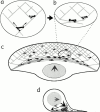Cell crawling: first the motor, now the transmission
- PMID: 9531543
- PMCID: PMC2132726
- DOI: 10.1083/jcb.141.1.1
Cell crawling: first the motor, now the transmission
Figures


Comment on
-
The Ig superfamily cell adhesion molecule, apCAM, mediates growth cone steering by substrate-cytoskeletal coupling.J Cell Biol. 1998 Apr 6;141(1):227-40. doi: 10.1083/jcb.141.1.227. J Cell Biol. 1998. PMID: 9531561 Free PMC article.

